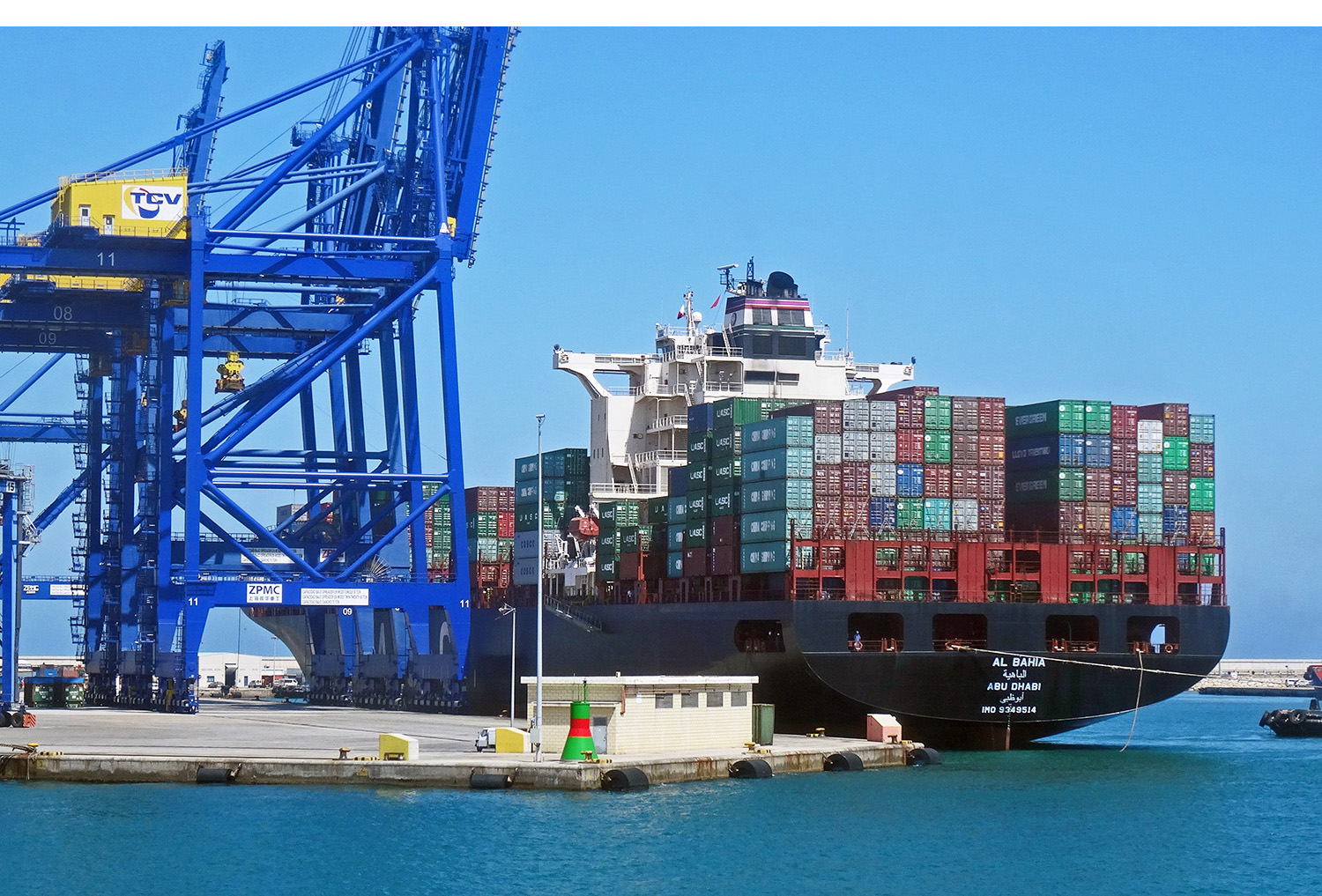 In an interview with Joe Rogan for his podcast, The Joe Rogan Experience, just before the US election, Donald Trump stated that, “To me, the most beautiful word – and I’ve said this for the last couple of weeks – in the dictionary today and any is the word ‘tariff’. It’s more beautiful than love; it’s more beautiful than anything. It’s the most beautiful word. This country can become rich with the use, the proper use of tariffs.”
In an interview with Joe Rogan for his podcast, The Joe Rogan Experience, just before the US election, Donald Trump stated that, “To me, the most beautiful word – and I’ve said this for the last couple of weeks – in the dictionary today and any is the word ‘tariff’. It’s more beautiful than love; it’s more beautiful than anything. It’s the most beautiful word. This country can become rich with the use, the proper use of tariffs.”
President-elect Trump has stated that he will impose tariffs on imports of 10% or 20%, with 60% and 100% tariffs on imports from China and Mexico, respectively. This protection for US industries, combined with lighter regulation, will, he claims, provide a stimulus to the economy and help create jobs. The revenues will also help to reduce America’s budget deficit.
But it is not that straightforward.
Problems with tariffs for the USA
 Imposing tariffs is likely to reduce international trade. But international trade brings net benefits, which are distributed between the participants according to the terms of trade. This is the law of comparative advantage.
Imposing tariffs is likely to reduce international trade. But international trade brings net benefits, which are distributed between the participants according to the terms of trade. This is the law of comparative advantage.
In the simple two-country case, the law states that, provided the opportunity costs of producing various goods differ between the two countries, both of them can gain from mutual trade if they specialise in producing (and exporting) those goods that have relatively low opportunity costs compared with the other country. The total production and consumption of the two countries will be higher.
So if the USA has a comparative advantage in various manufactured products and a trading partner has a comparative advantage in tropical food products, such as coffee or bananas, both can gain by specialisation and trade.
If tariffs are imposed and trade is thereby reduced between the USA and its trading partners, there will be a net loss, as production will switch from lower-cost production to higher-cost production. The higher costs of less efficient production in the USA will lead to higher prices for those goods than if they were imported.
 At the same time, goods that are still imported will be more expensive as the price will include the tariff. Some of this may be borne by the importer, meaning that only part of the tariff is passed on to the consumer. The incidence of the tariff between consumer and importer will depend on price elasticities of demand and supply. Nevertheless, imports will still be more expensive, allowing the domestically-produced substitutes to rise in price too, albeit probably by not so much. According to work by Kimberly Clausing and Mary E Lovely for the Peterson Institute (see link in Articles below), Trump’s proposals to raise tariffs would cost the typical American household over $2600 a year.
At the same time, goods that are still imported will be more expensive as the price will include the tariff. Some of this may be borne by the importer, meaning that only part of the tariff is passed on to the consumer. The incidence of the tariff between consumer and importer will depend on price elasticities of demand and supply. Nevertheless, imports will still be more expensive, allowing the domestically-produced substitutes to rise in price too, albeit probably by not so much. According to work by Kimberly Clausing and Mary E Lovely for the Peterson Institute (see link in Articles below), Trump’s proposals to raise tariffs would cost the typical American household over $2600 a year.
The net effect will be a rise in inflation – at least temporarily. Yet one of Donald Trump’s pledges is to reduce inflation. Higher inflation will, in turn, encourage the Fed to raise interest rates, which will dampen investment and economic growth.
Donald Trump tends to behave transactionally rather than ideologically. He is probably hoping that a rapid introduction of tariffs will then give the USA a strong bargaining position with foreign countries to trade more fairly. He is also hoping that protecting US industries by the use of tariffs, especially when coupled with deregulation, will encourage greater investment and thereby faster growth.
Much will depend on how other countries respond. If they respond by raising tariffs on US exports, any gain to industries from protection from imports will be offset by a loss to exporters.
A trade war, with higher tariffs, will lead to a net loss in global GDP. It is a negative sum game. In such a ‘game’, it is possible for one ‘player’ (country) to gain, but the loss to the other players (countries) will be greater than that gain.
 Donald Trump is hoping that by ‘winning’ such a game, the USA could still come out better off. But the gain from higher investment, output and employment in the protected industries would have to outweigh the losses to exporting industries and from higher import prices.
Donald Trump is hoping that by ‘winning’ such a game, the USA could still come out better off. But the gain from higher investment, output and employment in the protected industries would have to outweigh the losses to exporting industries and from higher import prices.
The first Trump administration (2017–21), as part of its ‘America First’ programme, imposed large-scale tariffs on Chinese imports and on steel and aluminium from across the world. There was wide-scale retaliation by other countries with tariffs imposed on a range of US exports. There was a net loss to world income, including US GDP.
Problems with US tariffs for the rest of the world
The imposition of tariffs by the USA will have considerable effects on other countries. The higher the tariffs and the more that countries rely on exports to the USA, the bigger will the effect be. China and Mexico are likely to be the biggest losers as they face the highest tariffs and the USA is a major customer. In 2023, US imports from China were worth $427bn, while US exports to China were worth just $148bn – only 34.6% of the value of imports. The percentage is estimated to be even lower for 2024 at around 32%. In 2023, China’s exports to the USA accounted for 12.6% of its total exports; Mexico’s exports to the USA accounted for 82.7% of its total exports.
It is possible that higher tariffs could be extended beyond China to other Asian countries, such as Vietnam, South Korea, Taiwan, India and Indonesia. These countries typically run trade surpluses with the USA. Also, many of the products from these countries include Chinese components.
As far as the UK is concerned, the proposed tariffs would cause significant falls in trade. According to research by Nicolò Tamberi at the University of Sussex (see link below in Articles):
The UK’s exports to the world could fall by £22 billion (–2.6%) and imports by £1.4 (–0.16%), with significant variations across sectors. Some sectors, like fishing and petroleum, are particularly hard-hit due to their high sensitivity to tariff changes, while others, such as textiles, benefit from trade diversion as the US shifts demand away from China.
Other badly affected sectors would include mining, pharmaceuticals, finance and insurance, and business services. The overall effect, according to the research, would be to reduce UK output by just under 1%.
Countries are likely to respond to US tariffs by imposing their own tariffs on US imports. World Trade Organization rules permit the use of retaliatory tariffs equivalent to those imposed by the USA. The more aggressive the resulting trade war, the bigger would be the fall in world trade and GDP.
The EU is planning to negotiate with Trump to avoid a trade war, but officials are preparing the details of retaliatory measures should the future Trump administration impose the threatened tariffs. The EU response is likely to be strong.
Articles
 The Most Beautiful Word In The Dictionary: Tariffs
The Most Beautiful Word In The Dictionary: TariffsYouTube, Joe Rogan and Donald Trump
- The exact thing that helped Trump win could become a big problem for his presidency
CNN, Matt Egan (7/11/24)
- Trump’s New Trade War With China Is Coming
Newsweek, Micah McCartney (9/11/24)
- Trump tariff threat looms large on several Asian countries – not just China – says Goldman Sachs
CNBC, Lee Ying Shan (11/11/24)
- Trump’s bigger tariff proposals would cost the typical American household over $2,600 a year
Peterson Institute for International Economics, Kimberly Clausing and Mary E Lovely (21/8/24)
- More tariffs, less red tape: what Trump will mean for key global industries
The Guardian, Jasper Jolly, Dan Milmo, Jillian Ambrose and Jack Simpson (7/11/24)
- Trump tariffs would halve UK growth and push up prices, says thinktank
The Guardian, Larry Elliott (6/11/24)
- China is trying to fix its economy – Trump could derail those plans
BBC News, João da Silva (8/11/24)
- Trump tariffs could cost UK £22bn of exports
BBC News, Faisal Islam & Tom Espiner (8/11/24)
- Trump to target EU over UK in trade war as he wants to see ‘successful Brexit’, former staffer claims
Independent, Millie Cooke (11/11/24)
- EU’s trade war nightmare gets real as Trump triumphs
Politico, Camille Gijs (6/11/24)
- Will Trump impose his tariffs? They could reduce the UK’s exports by £22 billion.
Centre for Inclusive Trade Policy, University of Sussex, Nicolò Tamberi (8/11/24)
- Three possible futures for the global economy if Trump brings in new trade tariffs
The Conversation, Agelos Delis and Sami Bensassi (17/12/24)
Questions
- Explain why, according to the law of comparative advantage, all countries can gain from trade.
- In what ways may the imposition of tariffs benefit particular sections of an economy?
- Is it in countries’ interests to retaliate if the USA imposes tariffs on their exports to the USA?
- Why is a trade war a ‘negative sum game’?
- Should the UK align with the EU in resisting President-elect Trump’s trade policy or should it seek independently to make a free-trade deal with the USA? is it possible to do both?
- What should China do in response to US threats to impose tariffs of 60% or more on Chinese imports to the USA?
 A common practice of international investors is to take part in the so-called ‘carry trade’. This involves taking advantage of nominal interest rate differences between countries. For example, assume that interest rates are low in Japan and high in the USA. It is thus profitable to borrow yen in Japan at the low interest rate, exchange it into US dollars and deposit the money at the higher interest rate available in the USA. If there is no change in the exchange rate between the dollar and the yen, the investor makes a profit equal to the difference in the interest rates.
A common practice of international investors is to take part in the so-called ‘carry trade’. This involves taking advantage of nominal interest rate differences between countries. For example, assume that interest rates are low in Japan and high in the USA. It is thus profitable to borrow yen in Japan at the low interest rate, exchange it into US dollars and deposit the money at the higher interest rate available in the USA. If there is no change in the exchange rate between the dollar and the yen, the investor makes a profit equal to the difference in the interest rates.
Rather than depositing the money in a US bank account, an alternative is to purchase US bonds or other assets in the USA, where the return is again higher than that in Japan.
If, however, interest-rate differentials narrow, there is the possibility of the carry trade ‘unwinding’. Not only may the carry trade prove unprofitable (or less so), but investors may withdraw their deposits and pay back the loans. This, as we shall, can have adverse consequences on exchange rates.
The problem of an unwinding of the carry trade is not new. It worsened the underlying problems of the financial crisis in 2008. The question today is whether history is about to repeat itself with a new round of unwinding of the carry trade threatening economic growth and recovery around the world.
We start by looking at what happened in 2008.
The carry trade and the 2008 financial crisis
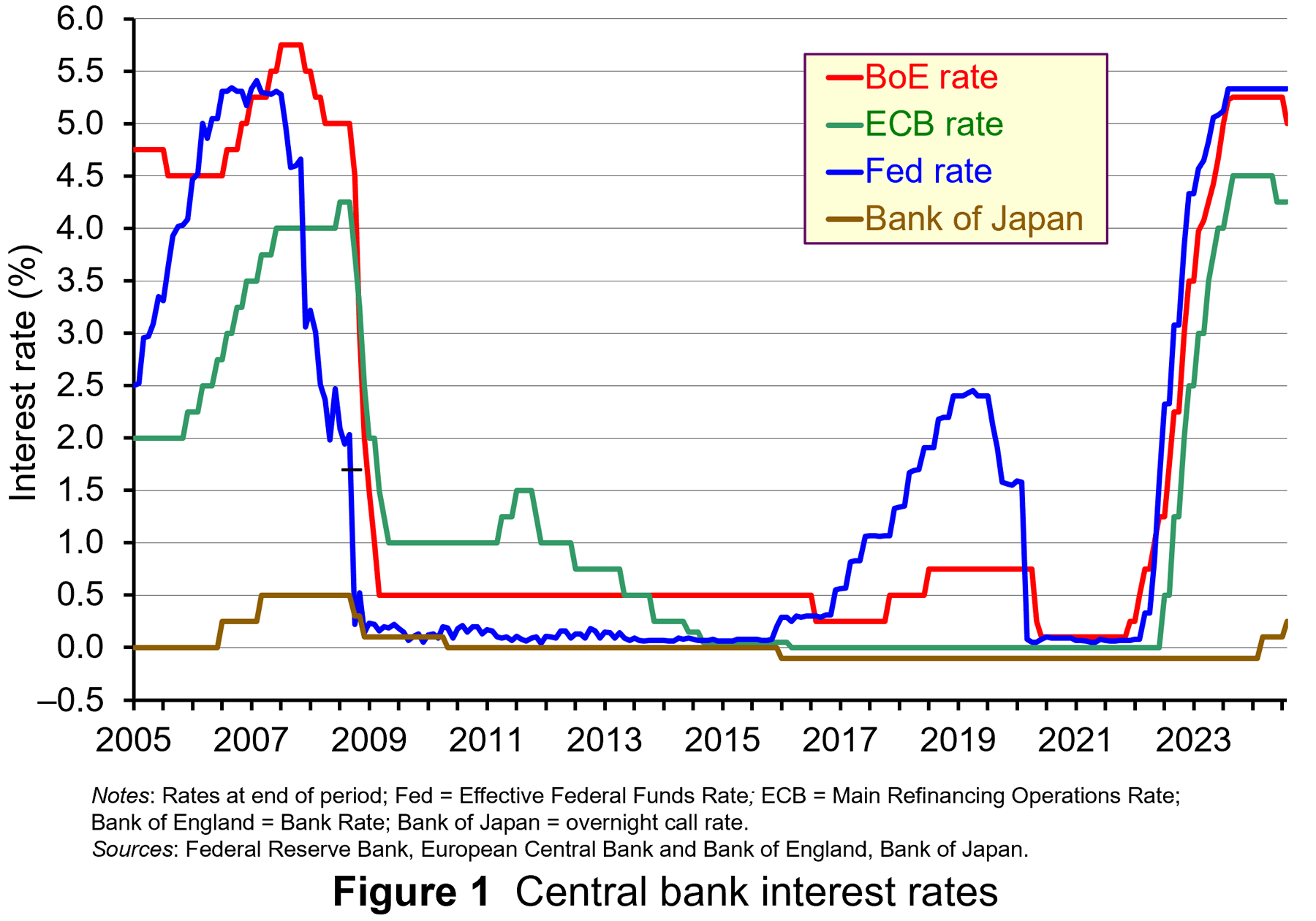 Prior to the financial crisis of 2008, current account deficit countries, such as the UK, USA and Australia, typically had relatively high interest rates, while current account surplus countries such as Japan and Switzerland had relatively low ones. Figure 1 shows central bank interest rates from 2005 to the current day (click here for a PowerPoint).
Prior to the financial crisis of 2008, current account deficit countries, such as the UK, USA and Australia, typically had relatively high interest rates, while current account surplus countries such as Japan and Switzerland had relatively low ones. Figure 1 shows central bank interest rates from 2005 to the current day (click here for a PowerPoint).
The carry trade saw investors borrowing money in Japan and Switzerland, exchanging it on the foreign exchange market, with the currency then deposited in the UK, USA and Australia. Hundreds of billions worth of dollars were involved in this carry trade.
If, however, the higher interest rates in the UK and other deficit countries were simply to compensate investors for the risk of currency depreciation, then there would be no excessive inflow of finance. The benefit of the higher interest rate would be offset by a depreciating currency. But the carry trade had the effect of making deficit currencies appreciate, thereby further boosting the carry trade by speculation of further exchange rate rises.
Thus the currencies of deficit countries appreciated, making their goods less competitive and worsening their current account deficit. Between 1996 and 2006, the average current account deficits as a percentage of GDP for Australia, the USA and the UK were close to 4½, 4 and 2, respectively. Between January 1996 and December 2006, the broad-based real exchange rate index of the Australian dollar appreciated by 17%, of the US dollar by 4% and of sterling by some 23%.
 Currencies of surplus countries depreciated, making their goods more competitive and further boosting their current account surpluses. For example, between 2004 and 2006 the average current account surpluses as a percentage of GDP for Japan and Switzerland were 3½ and 13, respectively. Their short-term interest rates averaged a mere 0.1% and 1.0% respectively (compared with 3.4%, 4.7% and 5.7% for the USA, the UK and Australia). Yet between January 2004 and December 2006, the real exchange rate index of the yen depreciated by 21%, while that of the Swiss franc depreciated by 6%.
Currencies of surplus countries depreciated, making their goods more competitive and further boosting their current account surpluses. For example, between 2004 and 2006 the average current account surpluses as a percentage of GDP for Japan and Switzerland were 3½ and 13, respectively. Their short-term interest rates averaged a mere 0.1% and 1.0% respectively (compared with 3.4%, 4.7% and 5.7% for the USA, the UK and Australia). Yet between January 2004 and December 2006, the real exchange rate index of the yen depreciated by 21%, while that of the Swiss franc depreciated by 6%.
With the credit crunch of 2007/8, the carry trade unwound. Much of the money deposited in the USA had been in highly risky assets, such as sub-prime mortgages. Investors scrambled to sell their assets in the USA, UK and the EU. Loans from Japan and Switzerland were repaid and these countries, seen as ‘safe havens’, attracted deposits. The currencies of deficit countries, such as the UK and USA, began to depreciate and those of surplus countries, such as Japan and Switzerland, began to appreciate. Between September 2007 and September 2008, the real exchange rate indices of the US dollar and sterling depreciated by 2% and 13% respectively; the yen and the Swiss franc appreciated by 3% and 2¾%.
This represented a ‘double whammy’ for Japanese exporters. Not only did its currency appreciate, making its exports more expensive in dollars, euros, pounds, etc., but the global recession saw consumers around the world buying less. As a result, the Japanese economy suffered the worst recession of the G7 economies.
The carry trade in recent months
Since 2016, there has been a re-emergence of the carry trade as the Fed began raising interest rates while the Bank of Japan kept rates at the ultra low level of –0.1% (see Figure 1). The process slowed down when the USA lowered interest rates in 2020 in response to the pandemic and fears of recession. But when the USA, the EU and the UK began raising rates at the beginning of 2022 in response to global inflationary pressures, while Japan kept its main rate at –0.1%, so the carry trade resumed in earnest. Cross-border loans originating in Japan (not all of it from the carry trade) had risen to ¥157tn ($1tn) by March 2024 – a rise of 21% from 2021.
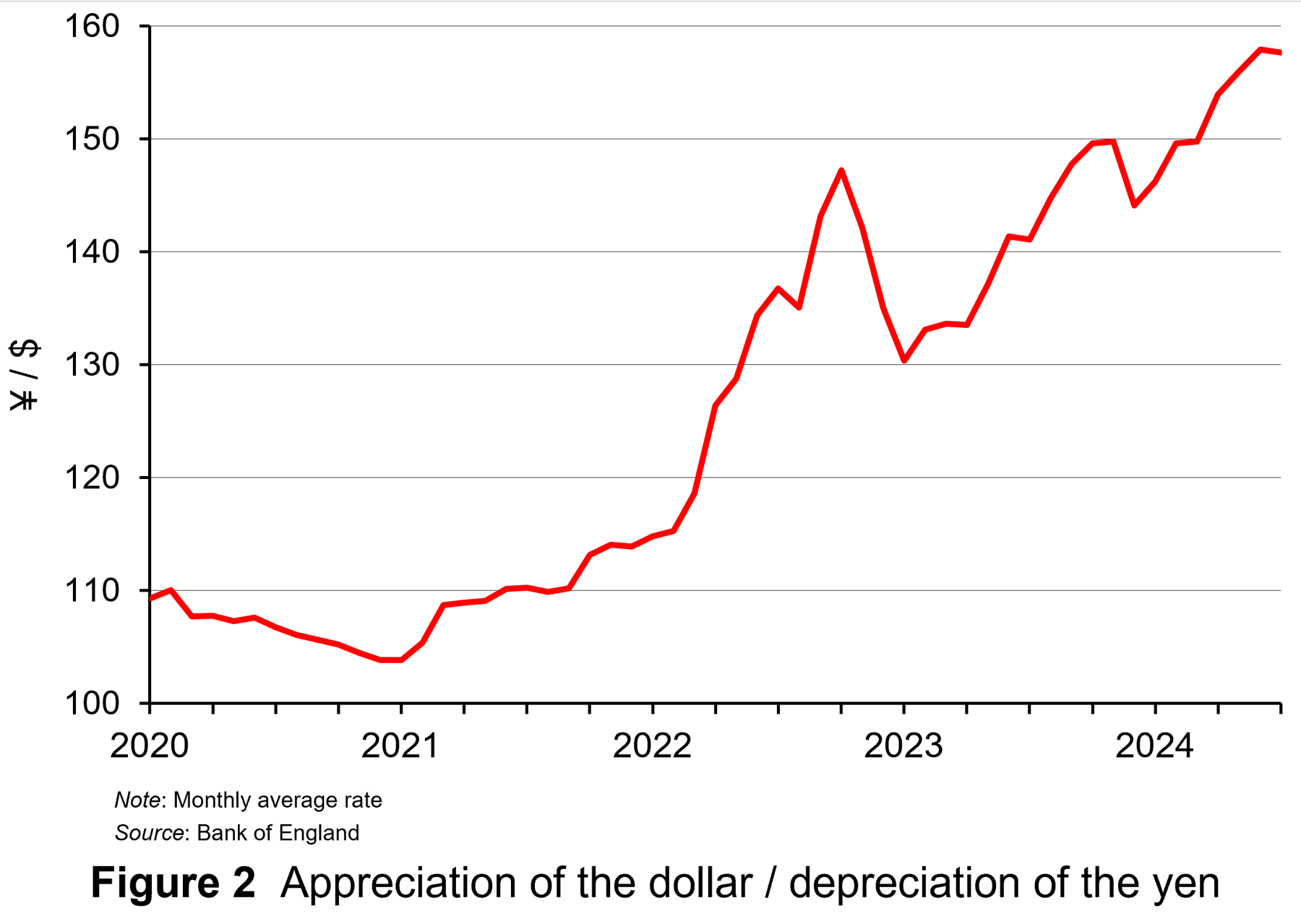 The process boosted US stock markets and contributed to the dollar appreciating against the yen (see Figure 2: click here for a PowerPoint).
The process boosted US stock markets and contributed to the dollar appreciating against the yen (see Figure 2: click here for a PowerPoint).
Although this depreciation of the yen helped Japanese exports, it also led to rising prices. Japanese inflation rose steadily throughout 2022. In the 12 months to January 2022 the inflation rate was 0.5% (having been negative from October 2020 to August 2021). By January 2023, the annual rate had risen to 4.3% – a rate not seen since 1981. The Bank of Japan was cautious about raising interest rates to suppress this inflation, however, for fear of damaging growth and causing the exchange rate to appreciate and thereby damaging exports. Indeed, quarterly economic growth fell from 1.3% in 2023 Q1 to –1.0% in 2023 Q3.
But then, with growth rebounding and the yen depreciating further, in March 2024 the Bank of Japan decided to raise its key rate from –0.1% to 0.1%. This initially had the effect of stabilising the exchange rate. But then with the yen depreciating further and inflation rising from 2.5% to 2.8% in May and staying at this level in June, the Bank of Japan increased the key rate again at the end of July – this time to 0.25% – and there were expectations that there would be another rise before the end of the year.
At the same time, there were expectations that the Fed would soon lower its main rate (the Federal Funds Rate) from its level of 5.33%. The ECB and the Bank of England had already begun lowering their main rates in response to lower inflation. The carry trade rapidly unwound. Investors sold US, EU and UK assets and began repaying yen loans.
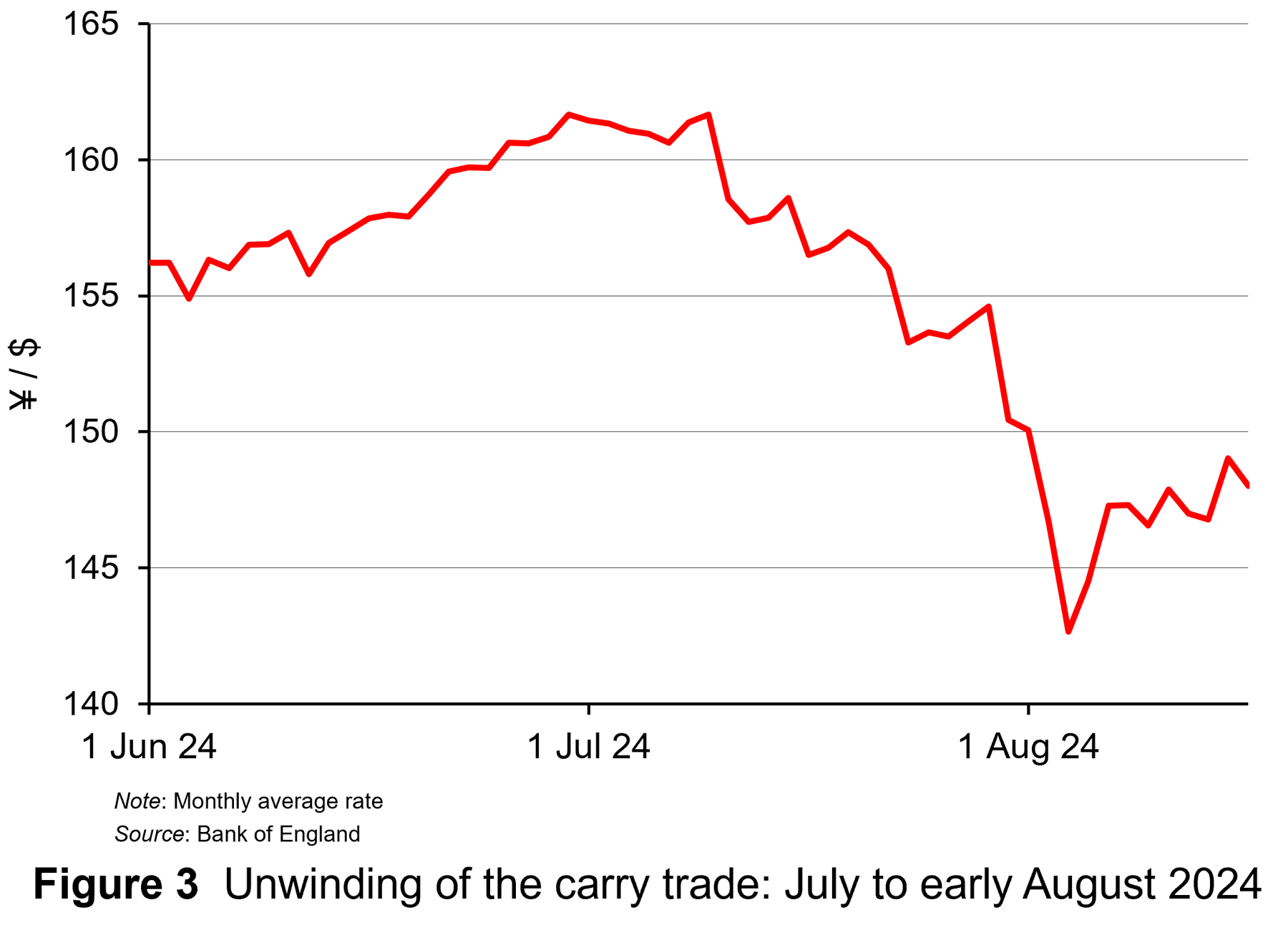 The result was a rapid appreciation of the yen as Figure 3 shows (click here for a PowerPoint). Between 31 July (the date the Bank of Japan raised interest rates the second time) and 5 August, the dollar depreciated against the yen from ¥150.4 to ¥142.7. In other words, the value of 100 yen appreciated from $0.66 to $0.70 – an appreciation of the yen of 6.1%.
The result was a rapid appreciation of the yen as Figure 3 shows (click here for a PowerPoint). Between 31 July (the date the Bank of Japan raised interest rates the second time) and 5 August, the dollar depreciated against the yen from ¥150.4 to ¥142.7. In other words, the value of 100 yen appreciated from $0.66 to $0.70 – an appreciation of the yen of 6.1%.
Fears about the unwinding of the carry trade led to falls in stock markets around the world. Not only were investors selling shares to pay back the loans, but fears of the continuing process put further downward pressure on shares. From 31 July to 5 August, the US S&P 500 fell by 6.1% and the tech-heavy Nasdaq by 8.0%.
 As far as the Tokyo stock market was concerned, the appreciation of the yen sparked fears that the large Japanese export sector would be damaged. Investors rushed to sell shares. Between 31 July and 5 August, the Nikkei 225 (the main Japanese stock market index) fell by 19.5% – its biggest short-term fall ever (see Figure 4: click here for a PowerPoint).
As far as the Tokyo stock market was concerned, the appreciation of the yen sparked fears that the large Japanese export sector would be damaged. Investors rushed to sell shares. Between 31 July and 5 August, the Nikkei 225 (the main Japanese stock market index) fell by 19.5% – its biggest short-term fall ever (see Figure 4: click here for a PowerPoint).
Although the yen has since depreciated slightly (a rise in the yen/dollar rate) and stock markets have recovered somewhat, expectations of many investors are that the unwinding of the yen carry trade has some way to go. This could result in a further appreciation of the yen from current levels of around ¥100 = $0.67 to around $0.86 in a couple of years’ time.
There are also fears about the carry trade in the Chinese currency, the yuan. Some $500 billion of foreign currency holdings have been acquired with yuan since 2022. As with the Japanese carry trade, this has been encouraged by low Chinese interest rates and a depreciating yuan. Not only are Chinese companies investing abroad, but foreign companies operating in China have been using their yuan earnings from their Chinese operations to invest abroad rather than in China. The Chinese carry trade, however, has been restricted by the limited convertibility of the yuan. If the Chinese carry trade begins to unwind when the Chinese economy begins to recover and interest rates begin to rise, the effect will probably be more limited than with the yen.
Articles
- A popular trading strategy just blew up in investors’ faces
CNN, Allison Morrow (7/8/24)
- The big ‘carry trade’ unwind is far from over, strategists warn
CNBC, Sam Meredith (13/8/24)
- Unwinding of yen ‘carry trade’ still threatens markets, say analysts
Financial Times, Leo Lewis and David Keohane (7/8/24)
- The yen carry trade sell-off marks a step change in the business cycle
Financial Times, John Plender (10/8/24)
- Forbes Money Markets Global Markets React To The Japanese Yen Carry Trade Unwind
Forbes, Frank Holmes (12/8/24)
- 7 unwinding carry trades that crashed the markets
Alt21 (26/1/23)
- A carry crash also kicked off the global financial crisis 17 years ago — here’s why it’s unlikely to get as bad this time
The Conversation, Charles Read (9/8/24)
- What is the Chinese yuan carry trade and how is it different from the yen’s?
Reuters, Winni Zhou and Summer Zhen (13/8/24)
- Carry Trade That Blew Up Markets Is Attracting Hedge Funds Again
Yahoo Finance/Bloomberg, David Finnerty and Ruth Carson (16/8/24)
- Currency Carry Trades 101
Investopedia, Kathy Lien (9/8/24)
- Carry Trades Torpedoed The Market. They’re Still Everywhere.
Finimize, Stéphane Renevier (13/8/24)
Questions
- What factors drive the currency carry trade?
- Is the carry trade a form of arbitrage?
- Find out and explain what has happened to the Japanese yen since this blog was written.
- Find out and explain some other examples of carry trades.
- Why are expectations so important in determining the extent and timing of the unwinding of carry trades?
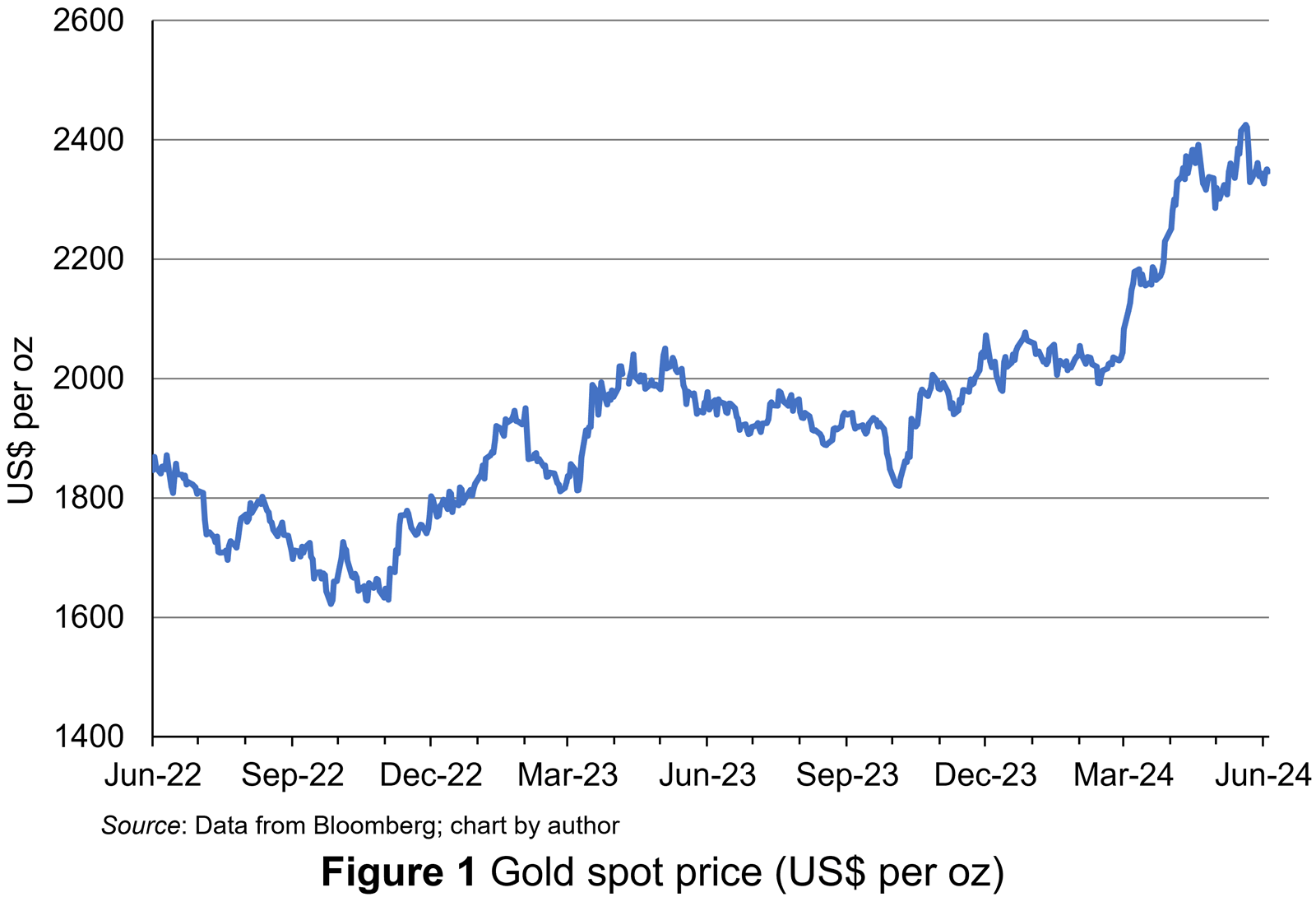 Gold has always held an allure and with the price of gold on international markets trending upwards since October 2022 (see Figure 1: click here for a PowerPoint), people seem to be attracted to it once again. The price reached successively higher peaks throughout 2023 before surging to above $2300 per oz in 2024 and peaking at $2425.31 per oz on 20 May 2024.
Gold has always held an allure and with the price of gold on international markets trending upwards since October 2022 (see Figure 1: click here for a PowerPoint), people seem to be attracted to it once again. The price reached successively higher peaks throughout 2023 before surging to above $2300 per oz in 2024 and peaking at $2425.31 per oz on 20 May 2024.
While gold tends to become attractive during wartime, economic uncertainty and bouts of inflation, all of which have characterised the last few years, the sustained price rise has perplexed market analysts and economists. The rally had been expected to peter out over the past 20 months. But, as the price of gold rose to sustained higher levels, with no significant reversals, some analysts have speculated that it is not the typical short-term factors which are driving the increased demand for and price of gold but more fundamental changes in the global economic system.
This blog will first discuss the typical short-term factors which influence gold prices before discussing the potential longer-term forces that may be at work.
Short-term factors
So, what are the typical short-term economic forces which drive the demand for gold?
The most significant are the real rates of interest on financial assets. These rates represent the opportunity cost of holding an asset such as gold which offers no income stream. When the real return from financial assets like debt and equity instruments is low, the demand for and price of gold tends to be high. In contrast, when the real return from such assets is high, the price of gold tends to be lower. An explanation for this is that real rates of return are strongly related to inflation rates and investors perceive gold as a hedge against inflation since its price is positively correlated with a general rise in prices. Higher unexpected inflation reduces the real rate of return of securities like debt and equity whose value is derived from cash flows anticipated in the future. In such circumstances, gold become an attractive alternative investment. As inflationary expectations decline, real returns from financial assets should rise, and the demand for gold should fall.
 The relationship between real returns, proxied by the yield on US 10-year TIPS (Treasury inflation-protected securities), and gold prices can be used to examine this explanation. Real returns rose steadily in the aftermath of the COVID-19 pandemic. Yet the price of gold, which rose during the early stages of the pandemic in 2020, has not fallen. Instead, it has remained at elevated levels for much of that time (see Figure 2: click here for a PowerPoint).
The relationship between real returns, proxied by the yield on US 10-year TIPS (Treasury inflation-protected securities), and gold prices can be used to examine this explanation. Real returns rose steadily in the aftermath of the COVID-19 pandemic. Yet the price of gold, which rose during the early stages of the pandemic in 2020, has not fallen. Instead, it has remained at elevated levels for much of that time (see Figure 2: click here for a PowerPoint).
There have been short periods when changes in real returns seemed to have a high correlation with changes in gold prices. In late 2022, for example, falling real rates coincided with rising gold prices. The same pattern was repeated between October and December 2023. However, when real returns rose again in the New Year of 2024, in response to stubbornly higher expected inflation and the expectation of ‘higher-for-longer’ interest rates, particularly in the USA, gold prices continued to rise. Indeed, across the 5-year period the correlation coefficient between the two series is actually positive at 0.268, showing little evidence supporting this explanation for the pattern for the gold price.
Real returns in the USA, however, may not be the correct ones to consider when seeking explanations for the pattern of gold’s price. Much of the recent demand is from China. Analysts suggest that Chinese investors are looking for a safe asset to hold as their economy stagnates and real returns from alternatives, like domestic property and equity, have decreased. Further, there are some concerns that the Chinese currency, the renminbi, may be undervalued in response to the sluggish growth. Holding gold is a good hedge against inflation (currency depreciation produces inflationary pressure). Consequently, the Chinese market may be exerting pricing power in relation to real returns in a way not seen before (see the Dempsey and Leng FT article linked below).
However, some analysts suggest that the rise in price is disproportionate to these short-term factors and point to potential long-term structural changes in the global financial order which may produce significant changes in the market for gold.
Long-term factors
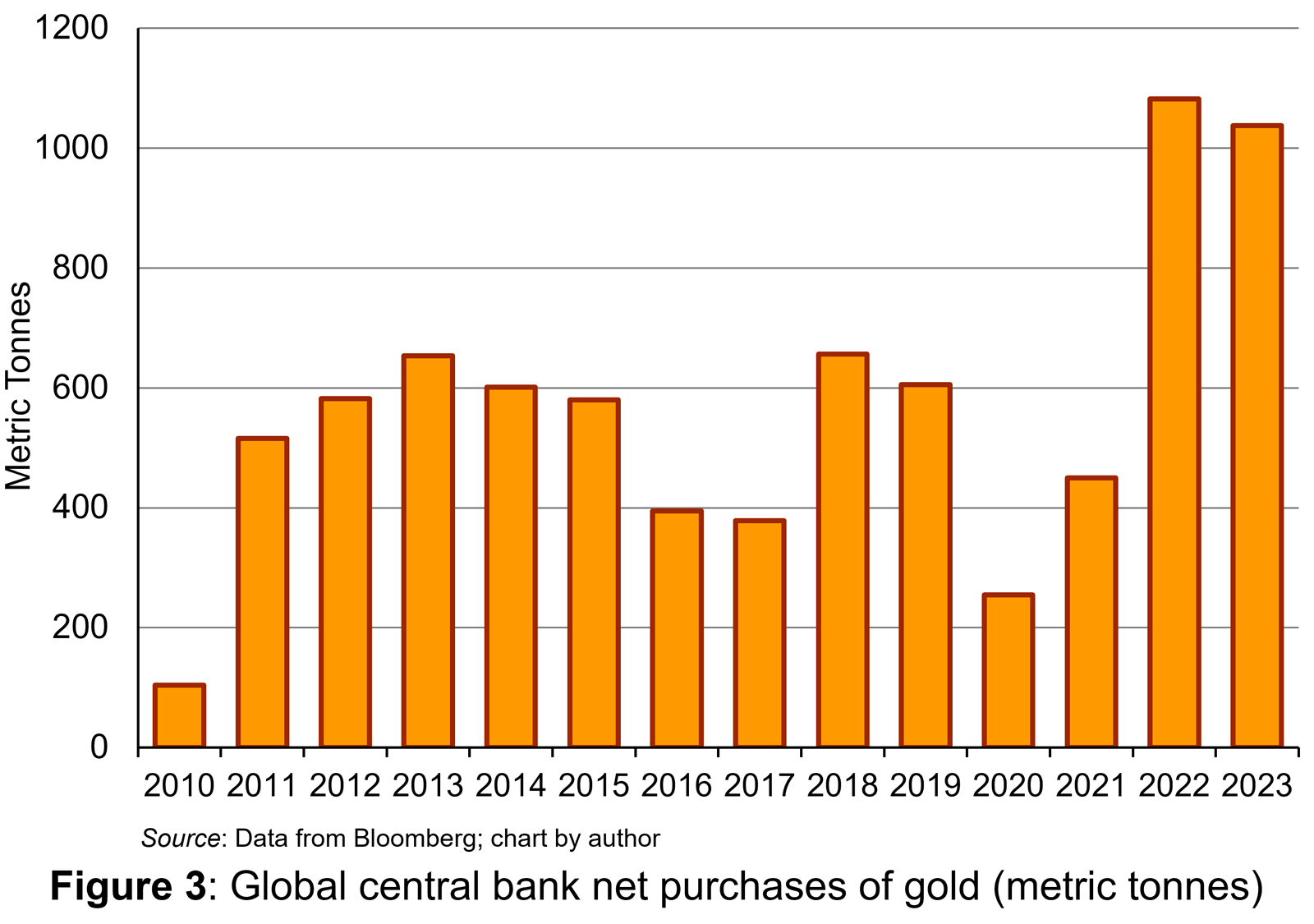 Since 2018, there have been bouts of gold purchasing by central banks around the world. In contrast to the 1990s and 2000s, central banks have been net purchasers since 2010. The purchasing fell back during the coronavirus pandemic but has surged again, with over 1000 metric tonnes purchased in both 2022 and 2023 (see Figure 3: click here for a PowerPoint).
Since 2018, there have been bouts of gold purchasing by central banks around the world. In contrast to the 1990s and 2000s, central banks have been net purchasers since 2010. The purchasing fell back during the coronavirus pandemic but has surged again, with over 1000 metric tonnes purchased in both 2022 and 2023 (see Figure 3: click here for a PowerPoint).
Analysts have pointed to similarities between the recent pattern and central bank purchases of gold during the late 1960s and early 1970s (see The Conversation article linked below). Then, central banks sought to diversify themselves from dollar-denominated assets due to concerns about higher inflation in the USA and its impact on the value of the US dollar. Under the Bretton Woods fixed exchange rate system, central banks could redeem dollars for gold from the US Federal Reserve at a fixed rate. The pressure on the USA to redeem the gold led to the collapse of the Bretton Woods fixed exchange rate system.
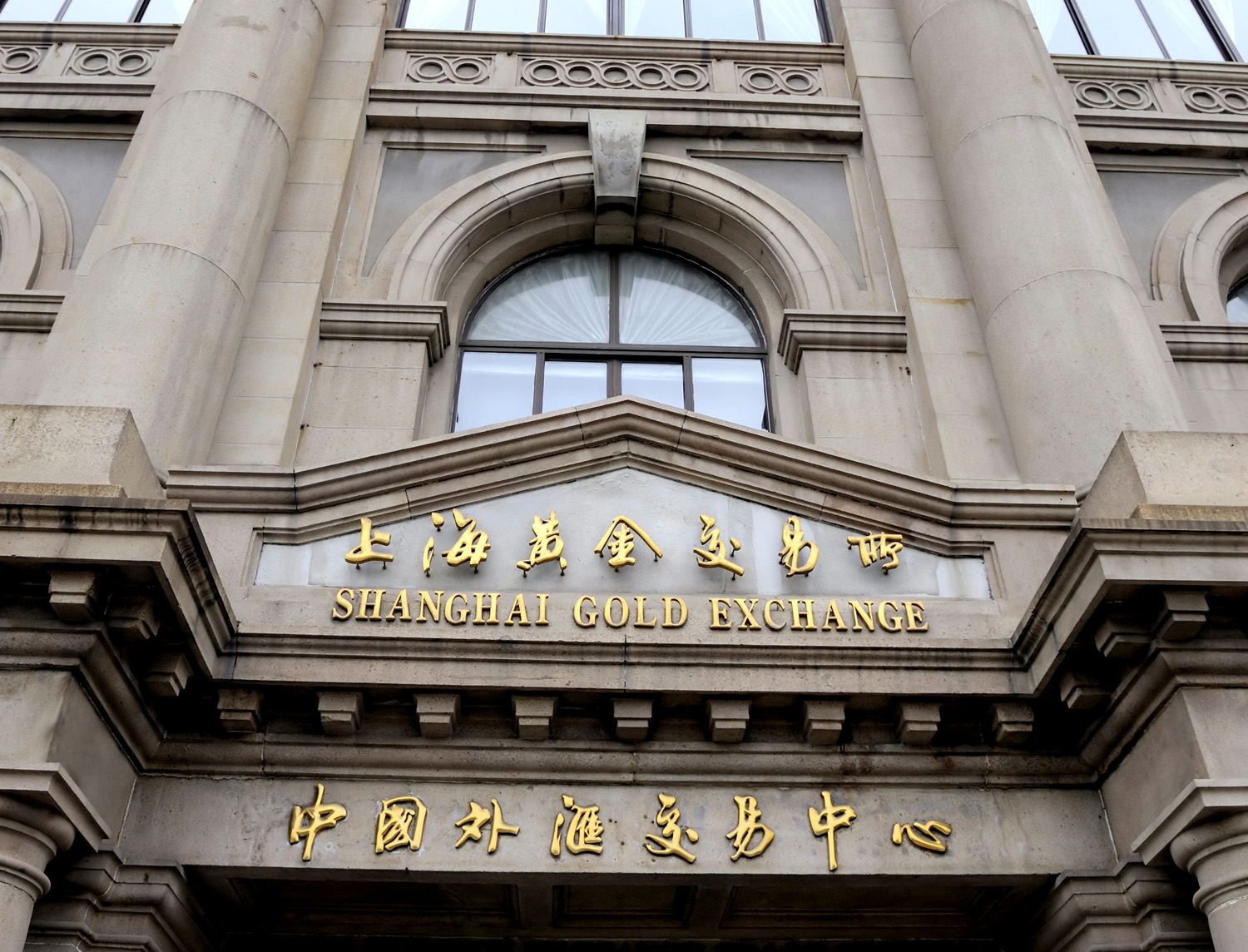 While the current period of central bank purchases does not appear to be related to expected inflation, some commentators suggest it could signal a regime change in the global financial system as significant as the collapse of Bretton Woods. The rise of Chinese political power and the resurgence of US isolationist tendencies portend an increasingly multipolar geopolitical scene. Such concerns may cause central bankers to diversify away from dollar denominated assets to avoid being caught out by geopolitical tensions. Gold may be perceived as an asset through which investors can hedge that risk better.
While the current period of central bank purchases does not appear to be related to expected inflation, some commentators suggest it could signal a regime change in the global financial system as significant as the collapse of Bretton Woods. The rise of Chinese political power and the resurgence of US isolationist tendencies portend an increasingly multipolar geopolitical scene. Such concerns may cause central bankers to diversify away from dollar denominated assets to avoid being caught out by geopolitical tensions. Gold may be perceived as an asset through which investors can hedge that risk better.
Indeed, the rise in demand among Chinese investors may indicate a reluctance to hold US assets due to their risk of seizure during heightened geopolitical tensions between China and the USA. Chinese holdings of US financial assets as a percentage of GDP are back to the level they were when the country joined the World Trade Organisation (WTO) in 2001 (see the Rana Foroohar FT article linked below). Allied to this is an increasing tendency to repatriate gold bullion from centres such as London and New York.
Added to these worries about geopolitical risk are concerns about traditional safe-haven assets – government debt securities. US government budget deficits and debt levels continue to rise. Similar patterns are observed across many developed market economies (DMEs). Analysts are concerned such debts are reaching unsustainable levels (economist.com). The view is that at some point, perhaps soon, a tipping point will be reached where investors recognise this. They will demand higher rates of return on these government debt securities, pushing yields up and prices down (bond yields and prices have a negative relationship).
In expectation of this, investors may be wary of holding such government debt securities and move to hold gold as an alternative safe-haven asset to avoid potential capital losses. However, there has been no sign of this behaviour in bond prices and yields yet.
 Finally, there are economists who argue that the increased demand for gold is caused by a different regime-change in the global economy. This is not one driven by geopolitics, but by changing inflationary expectations – from a low-inflation, low-interest-rate environment to a higher-inflation, higher-interest-rate environment.
Finally, there are economists who argue that the increased demand for gold is caused by a different regime-change in the global economy. This is not one driven by geopolitics, but by changing inflationary expectations – from a low-inflation, low-interest-rate environment to a higher-inflation, higher-interest-rate environment.
Some of the anticipation relating to inflation is derived from the persistent fiscal stimulus, evidenced by the higher government debt levels described above, coupled with the long period of monetary stimulus (quantitative easing) in developed market economies during the 2010s.
Further, some economists highlight the substantial capital investment needed for the green transition and reindustrialisation. While the financing for this capital investment may absorb some of the excess money flowing around financial markets, the scale involved will create a great demand for resources, fuelling inflation and raising the cost of capital as borrowers compete for resources.
Finally, the demographic forces from an aging population will also cause inflationary pressures. Rising dependency ratios across many developed market economics will create shortages, particularly of labour. This persistent scarcity of labour will continually drive up wages and prices, fuelling inflation and the demand for gold.
Conclusion
The recent surge in the price of gold has led to great interest by investors, financial market analysts and economists. At first, there was a perception that the price increase was similar to recent history and driven by short-term decreases in the real rate of return from financial assets, which reduced the opportunity cost of holding gold.
However, as the upward trend in the price of gold has persisted and does not seem to be explained by changes in real interest rates, economists have considered other reasons that might signal longer-term significant changes in the global financial system. These relate to changing geopolitical risk derived from an increasingly multipolar environment, concerns about the sustainability of government debt levels and expectations of persistently higher inflation in the world economy.
Only time will tell whether these explanations prove correct. If inflationary pressures subside, particularly in the USA, and if real returns from financial assets rebound, a decrease in the demand for and price of gold will suggest that the previous rise was driven by short-term forces.
If prices don’t fall back, it will only fuel the debate that it is a sign of significant changes in the global financial order.
Articles
- Gold’s weird rally
Financial Times, Robert Armstrong & Ethan Wu (11/12/23)
- A debt crisis at the economy’s edge
Financial Times, Robert Armstrong (15/5/24)
- Good, not great, news on inflation
Financial Times, Robert Armstrong (16/5/24)
- Gold prices are ‘dramatically outperforming’: Macquarie
Investing.com, Senad Karaahmetovic (30/5/24)
- Gold is back — and it has a message for us
Financial Times, Rana Foroohar (15/4/24)
- Countries went on a gold-buying spree before coronavirus took hold – here’s why
The Conversation, Drew Woodhouse (21/5/20)
- Why Gold Keeps Hitting Record Highs
Investopedia, Colin Laidley (9/4/24)
- Why Is the Price of Gold Rising?
Forbes, Wayne Duggan (23/4/24)
- Why gold prices are hitting record highs
TRT World, Kazim Alam (3/4/24)
- Chinese speculators super-charge gold rally
Financial Times, Harry Dempsey and Cheng Leng (23/4/24)
- This gold rally is made in China
Financial Times, Opinion Lex (21/5/24)
Speech
Data
Questions
- Explain the relationship between real returns and inflation for financial securities like debt and equity.
- Why is gold perceived to be an effective hedge against inflation?
- Contrast the factors which influenced the demand for gold in the period which preceded the end of Bretton Woods with those influencing demand now?
- What has happened to the price of gold since this blog was published? Is there any evidence for the profound changes in the global economic order suggested or was it the short-term forces driving demand after all?

Climate change is not just an environmental challenge: its socioeconomic impacts are profound and far-reaching, touching every aspect of society. From agriculture to health, from urban infrastructure to coastal communities, the effects of climate change are evident and escalating.
The far-reaching effects
In agriculture, rising temperatures, more intense and frequent heatwaves and changing precipitation patterns pose significant threats to food security.1, 2 Crop yields decline as extreme weather events become more frequent and unpredictable, leading to increased food prices and economic instability. Smallholder farmers, who often lack the resources to adapt, are particularly vulnerable, exacerbating rural poverty and food insecurity.3
 Coastal communities face the dual threats of sea-level rise and more intense storms.4 Erosion and inundation damage homes, infrastructure and livelihoods, displacing populations and disrupting local economies. The loss of coastal ecosystems further compounds these challenges, reducing natural defences against storm surges and exacerbating the impacts of climate-related disasters.
Coastal communities face the dual threats of sea-level rise and more intense storms.4 Erosion and inundation damage homes, infrastructure and livelihoods, displacing populations and disrupting local economies. The loss of coastal ecosystems further compounds these challenges, reducing natural defences against storm surges and exacerbating the impacts of climate-related disasters.
Health systems strain under the burden of climate-change-induced heatwaves, air pollution and the spread of vector-borne diseases.5, 6 Heat-related illnesses increase as temperatures rise, particularly affecting vulnerable populations such as the elderly and outdoor workers. Air pollution exacerbates respiratory conditions, leading to higher healthcare costs and decreased productivity. Vector-borne diseases, such as malaria and dengue fever, expand into new regions, placing additional strain on already overburdened health systems.
 Displacement due to climate-related disasters amplifies social inequalities and challenges urban planning and infrastructure.7 Vulnerable communities, often located in low-lying areas or informal settlements, bear the brunt of climate impacts, facing the loss of homes, livelihoods and community cohesion. Inadequate housing and infrastructure increase the risks associated with extreme weather events, perpetuating cycles of poverty and vulnerability.
Displacement due to climate-related disasters amplifies social inequalities and challenges urban planning and infrastructure.7 Vulnerable communities, often located in low-lying areas or informal settlements, bear the brunt of climate impacts, facing the loss of homes, livelihoods and community cohesion. Inadequate housing and infrastructure increase the risks associated with extreme weather events, perpetuating cycles of poverty and vulnerability.
Furthermore, climate change exacerbates existing socioeconomic disparities, disproportionately affecting marginalised and vulnerable populations. Indigenous communities, women, children and people living in poverty are often the hardest hit, lacking access to resources, information, and adaptive capacity.8
Policy responses
Addressing the socioeconomic impacts of climate change requires co-ordinated action across sectors and scales. Policy interventions, such as investment in climate-resilient infrastructure and the promotion of sustainable agriculture practices, are essential for building resilience and reducing vulnerability. Community-led initiatives that prioritise local knowledge and empower marginalised groups are also critical for fostering adaptive capacity and promoting social equity.
To address these challenges, projects like CROSSEU, the new €5 million Horizon Europe project (that I have the pleasure to be part of), play a crucial role in enhancing our understanding of these impacts and developing actionable strategies for resilience and adaptation. One of the key contributions of CROSSEU lies in its development of a Decision Support System (DSS) that integrates tools, measures, and policy options to address these risks in a cross-sectoral and cross-regional perspective. This DSS will support (and hopefully improve) decision-making processes at various levels, from local to EU-wide, and facilitate the adoption of evidence-based policies and measures to enhance resilience and mitigate the impacts of climate change.
Would you like to know more about CROSSEU? Follow our journey and be informed of our publications and events in our new webpage: https://crosseu.eu/9
Articles/References
- Global food security under climate change
Proceedings of the National Academy of Sciences, Josef Schmidhuber and Francesco N Tubiello (11/12/2007)
- Reducing risks to food security from climate change
Global Food Security, Bruce M Campbell et al. (2016: 11, pp 34–43)
- The value-add of tailored seasonal forecast information for industry decision making
Climate, Clare Mary Goodess et al (16/10/2022)
- Assessing climate change impacts, sea level rise and storm surge risk in port cities: a case study on Copenhagen
Climatic change, Stéphane Hallegatte, Nicola Ranger, Olivier Mestre, Patrice Dumas, Jan Corfee-Morlot, Celine Herweijer and Robert Muir Wood (7/12/2010)
- Health risks of climate change: An assessment of uncertainties and its implications for adaptation policies
Environmental Health, J Arjan Wardekker, Arie de Jong, Leendert van Bree, Wim C Turkenburg and Jeroen P van der Sluijs (19/9/2012)
- Climate Change and Temperature-related Mortality: Implications for Health-related Climate Policy
Biomedical and Environmental Sciences, Tong Shi Lu, Jorn Olsen and Patrick L Kinney (2021: 34(5) pp 379–86 )
- Climate Change, Inequality, and Human Migration
IZA Discussion Paper No. 12623, Michał Burzyński, Christoph Deuster, Frédéric Docquier and Jaime de Melo (23/9/2019)
- The trap of climate change-induced “natural” disasters and inequality
Global Environmental Change, Federica Cappelli, Valeria Costantini and Davide Consoli (30/7/2021)
- Cross-sectoral Framework for Socio-Economic Resilience to Climate Change and Extreme Events in Europe
UEA Research Project, Nicholas Vasilakos, Katie Jenkins and Rachel Warren
Questions
- How do the socioeconomic impacts of climate change differ between rural and urban communities? What factors contribute to these disparities, and how can policies address them effectively?
- In what ways do vulnerable populations, such as indigenous communities and those living in poverty, bear the brunt of climate change impacts? How can we ensure that climate adaptation strategies prioritise their needs and promote social equity?
- The blog mentions the importance of community-led initiatives in building resilience to climate change. What examples of successful community-based adaptation projects can you identify, and what lessons can be learned from their implementation?
- How can governments and organisations collaborate to address the socioeconomic impacts of climate change while also promoting economic growth and development? What role do cross-sectoral partnerships play in building resilience and fostering sustainable practices?
 According to the IMF, Chinese GDP grew by 5.2% in 2023 and is predicted to grow by 4.6% this year. Such growth rates would be extremely welcome to most developed countries. UK growth in 2023 was a mere 0.5% and is forecast to be only 0.6% in 2024. Advanced economies as a whole only grew by 1.6% in 2023 and are forecast to grow by only 1.5% this year. Also, with the exception of India, the Philippines and Indonesia, which grew by 6.7%, 5.3% and 5.0% respectively in 2023 and are forecast to grow by 6.5%, 6.0% and 5.0% this year, Chinese growth also compares very favourably with other developing countries, which as a weighted average grew by 4.1% last year and are forecast to grow at the same rate this year.
According to the IMF, Chinese GDP grew by 5.2% in 2023 and is predicted to grow by 4.6% this year. Such growth rates would be extremely welcome to most developed countries. UK growth in 2023 was a mere 0.5% and is forecast to be only 0.6% in 2024. Advanced economies as a whole only grew by 1.6% in 2023 and are forecast to grow by only 1.5% this year. Also, with the exception of India, the Philippines and Indonesia, which grew by 6.7%, 5.3% and 5.0% respectively in 2023 and are forecast to grow by 6.5%, 6.0% and 5.0% this year, Chinese growth also compares very favourably with other developing countries, which as a weighted average grew by 4.1% last year and are forecast to grow at the same rate this year.
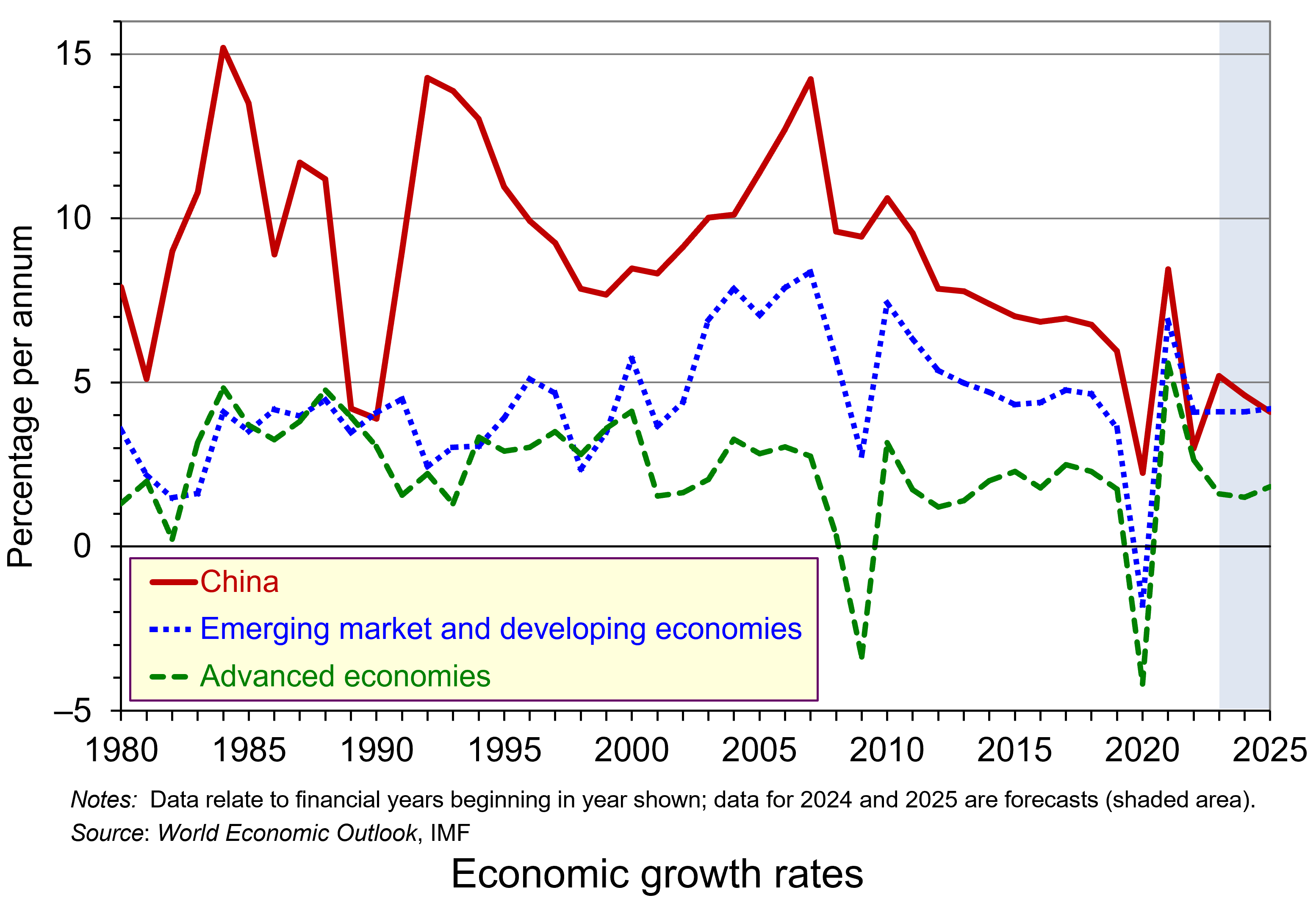 But in the past, Chinese growth was much higher and was a major driver of global growth. Over the period 1980 to 2018, Chinese economic growth averaged 9.5% – more than twice the average rate of developing countries (4.5%) and nearly four times the average rate of advanced countries (2.4%) (see chart – click here for a PowerPoint of the chart).
But in the past, Chinese growth was much higher and was a major driver of global growth. Over the period 1980 to 2018, Chinese economic growth averaged 9.5% – more than twice the average rate of developing countries (4.5%) and nearly four times the average rate of advanced countries (2.4%) (see chart – click here for a PowerPoint of the chart).
Not only is Chinese growth now much lower, but it is set to decline further. The IMF forecasts that in 2025, Chinese growth will have fallen to 4.1% – below the forecast developing-country average of 4.2% and well below that of India (6.5%).
Causes of slowing Chinese growth
There are a number of factors that have come together to contribute to falling economic growth rates – growth rates that otherwise would have been expected to be considerably higher as the Chinese economy reopened after severe Covid lockdowns.
 Property market
Property market
China has experienced a property boom over the past 20 years years as the government has encouraged construction in residential blocks and in factories and offices. The sector has accounted for some 20% of economic activity. But for many years, demand outstripped supply as consumers chose to invest in property, partly because of a lack of attractive alternatives for their considerable savings and partly because property prices were expected to go on rising. This lead to speculation on the part of both buyers and property developers. Consumers rushed to buy property before prices rose further and property developers borrowed considerably to buy land, which local authorities encouraged, as it provided a valuable source of revenue.
But now there is considerable overcapacity in the sector and new building has declined over the past three years. According to the IMF:
Housing starts have fallen by more than 60 per cent relative to pre-pandemic levels, a historically rapid pace only seen in the largest housing busts in cross-country experience in the last three decades. Sales have fallen amid homebuyer concerns that developers lack sufficient financing to complete projects and that prices will decline in the future.
As a result, many property developers have become unviable. At the end of January, the Chinese property giant, Evergrande, was ordered to liquidate by a Hong Kong court, after the judge ruled that the company did not have a workable plan to restructure around $300bn of debt. Over 50 Chinese property developers have defaulted or missed payments since 2020. The liquidation of Evergrande and worries about the viability of other Chinese property developers is likely to send shockwaves around the Chinese property market and more widely around Chinese investment markets.
Overcapacity
Rapid investment over many years has led to a large rise in industrial capacity. This has outstripped demand. The problem could get worse as investment, including state investment, is diverted from the property sector to manufacturing, especially electric vehicles. But with domestic demand dampened, this could lead to increased dumping on international markets – something that could spark trade wars with the USA and other trading partners (see below). Worries about this in China are increasing as the possibility of a second Trump presidency looks more possible. The Chinese authorities are keen to expand aggregate demand to tackle this overcapacity.
Uncertainty
Consumer and investor confidence are low. This is leading to severe deflationary pressures. If consumers face a decline in the value of their property, this wealth effect could further constrain their spending. This will, in turn, dampen industrial investment.
Uncertainty is beginning to affect foreign companies based in China. Many foreign companies are now making a loss in China or are at best breaking even. This could lead to disinvestment and add to deflationary pressures.
The Chinese stock market and policy responses
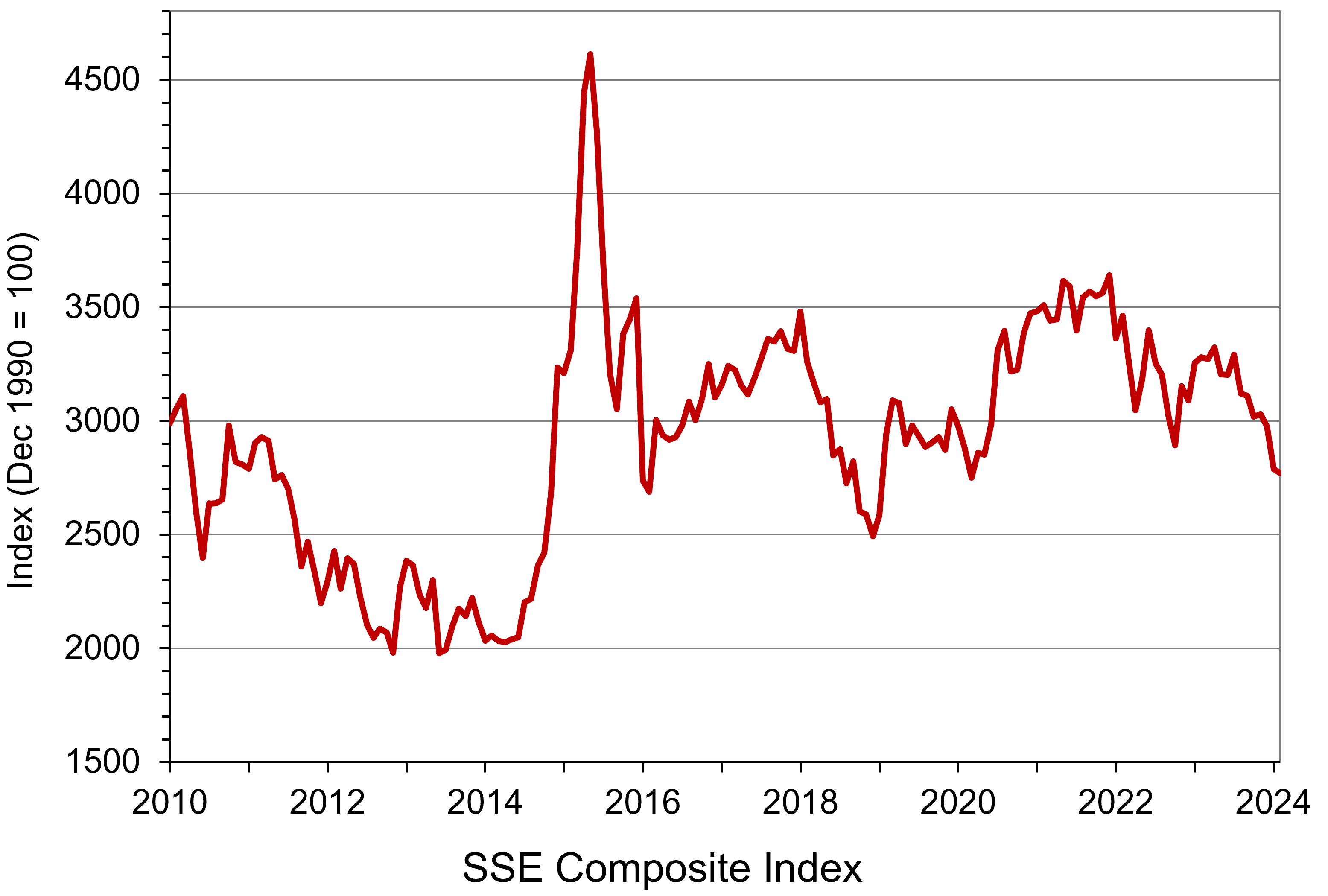 Lack of confidence in the Chinese economy is reflected in falling share prices. The Shanghai SSE Composite Index (an index of all stocks traded on the Shanghai Stock Exchange) has fallen dramatically in recent months. From a high of 3703 in September 2021, it had fallen to 2702 on 5 Feb 2024 – a fall of 27%. It is now below the level at the beginning of 2010 (see chart: click here for a PowerPoint). On 5 February alone, some 1800 stocks fell by over 10% in Shanghai and Shenzhen. People were sensing a rout and investors expressed their frustration and anger on social media, including the social media account of the US Embassy. The next day, the authorities intervened and bought large quantities of key stocks. China’s sovereign wealth fund announced that it would increase its purchase of shares to support the country’s stock markets. The SSE Composite rose 4.1% on 6 February and the Shenzhen Component Index rose 6.2%.
Lack of confidence in the Chinese economy is reflected in falling share prices. The Shanghai SSE Composite Index (an index of all stocks traded on the Shanghai Stock Exchange) has fallen dramatically in recent months. From a high of 3703 in September 2021, it had fallen to 2702 on 5 Feb 2024 – a fall of 27%. It is now below the level at the beginning of 2010 (see chart: click here for a PowerPoint). On 5 February alone, some 1800 stocks fell by over 10% in Shanghai and Shenzhen. People were sensing a rout and investors expressed their frustration and anger on social media, including the social media account of the US Embassy. The next day, the authorities intervened and bought large quantities of key stocks. China’s sovereign wealth fund announced that it would increase its purchase of shares to support the country’s stock markets. The SSE Composite rose 4.1% on 6 February and the Shenzhen Component Index rose 6.2%.
However, the rally eased as investors waited to see what more fundamental measures the authorities would take to support the stock markets and the economy more generally. Policies are needed to boost the wider economy and encourage a growth in consumer and business confidence.
Interest rates have been cut four times since the beginning of 2022, when the prime loan rate was cut from 3.85% to 3.7%. The last cut was from 3.55% to 3.45% in August 2023. But this has been insufficient to provide the necessary boost to aggregate demand. Further cuts in interest rates are possible and the government has said that it will use proactive fiscal and effective monetary policy in response to the languishing economy. However, government debt is already high, which limits the room for expansionary fiscal policy, and consumers are highly risk averse and have a high propensity to save.
Graduate unemployment
 China has seen investment in education as an important means of increasing human capital and growth. But with a slowing economy, there are are more young people graduating each year than there are graduate jobs available. Official data show that for the group aged 16–24, the unemployment rate was 14.9% in December. This compares with an overall urban unemployment rate of 5.1%. Many graduates are forced to take non-graduate jobs and graduate jobs are being offered at reduced salaries. This will have a further dampening effect on aggregate demand.
China has seen investment in education as an important means of increasing human capital and growth. But with a slowing economy, there are are more young people graduating each year than there are graduate jobs available. Official data show that for the group aged 16–24, the unemployment rate was 14.9% in December. This compares with an overall urban unemployment rate of 5.1%. Many graduates are forced to take non-graduate jobs and graduate jobs are being offered at reduced salaries. This will have a further dampening effect on aggregate demand.
Demographics
China’s one-child policy, which it pursued from 1980 to 2016, plus improved health and social care leading to greater longevity, has led to an ageing population and a shrinking workforce. This is despite recent increases in unemployment in the 16–24 age group. The greater the ratio of dependants to workers, the greater the brake on growth as taxes and savings are increasingly used to provide various forms of support.
Effects on the rest of the world
China has been a major driver of world economic growth. With a slowing Chinese economy, this will provide less stimulus to growth in other countries. Many multinational companies, including chip makers, cosmetics companies and chemical companies, earn considerable revenue from China. For example, the USA exports over $190 billion of goods and services to China and these support over 1 million jobs in the USA. A slowdown in China will have repercussions for many companies around the world.
There is also the concern that Chinese manufacturers may dump products on world markets at less than average (total) cost to shift stock and keep production up. This could undermine industry in many countries and could initiate a protectionist response. Already Donald Trump is talking about imposing a 10% tariff on most imported goods if he is elected again in November. Such tariffs could be considerably higher on imports from China. If Joe Biden is re-elected, he too may impose tariffs on Chinese goods if they are thought to be unfairly subsidised. US (and possibly EU) tariffs on Chinese goods could lead to a similar response from China, resulting in a trade war – a negative sum game.
Videos
Articles
- IMF Predicts China Economy Slowing Over Next Four Years
Voice of America, Evie Steele (2/2/24)
- China’s Real Estate Sector: Managing the Medium-Term Slowdown
IMF News, Henry Hoyle and Sonali Jain-Chandra (2/2/24)
- China braced for largest human migration on earth amid bleak economic backdrop
ITV News, Debi Edward (4/2/24)
- China’s property giant Evergrande ordered to liquidate as debt talks fail
Aljazeera (29/1/24)
- China’s overcapacity a challenge that is ‘here to stay’, says US chamber
Financial Times, Joe Leahy (1/2/24)
- China needs to learn lessons from 1990s Japan
Financial Times, Gillian Tett (1/2/24)
- The Trump factor is looming over China’s markets
Financial Times, Katie Martin (2/2/24)
- China’s many systemic problems dominate its outlook for 2024
The Guardian, George Magnus (1/1/24)
- China youth unemployment will stay elevated in 2024, but EIU warns economic impact will linger
CNBC, Clement Tan (25/1/24)
- Don’t count on a soft landing for the world economy – turbulence is ahead
The Guardian, Kenneth Rogoff (2/2/24)
- As falling stocks draw criticism in China, censors struggle to keep up
Washington Post, Lily Kuo (6/2/24)
- China’s doom loop: a dramatically smaller (and older) population could create a devastating global slowdown
The Conversation, Jose Caballero (12/2/24)
- China: why the country’s economy has hit a wall – and what it plans to do about it
The Conversation, Hong Bo (19/3/24)
- Confronting inflation and low growth
OECD Economic Outlook Interim Report (September 2023) (see especially Box 1)
Questions
- Why is China experiencing slowing growth and is growth likely to pick up over the next five years?
- How does the situation in China today compare with that in Japan 30 years ago?
- What policies could the Chinese government pursue to stimulate economic growth?
- What policies were enacted towards China during the Trump presidency from 2017 to 2020?
- Would you advise the Chinese central bank to cut interest rates further? Explain.
- Should China introduce generous child support for families, no matter the number of children?
 In an interview with Joe Rogan for his podcast, The Joe Rogan Experience, just before the US election, Donald Trump stated that, “To me, the most beautiful word – and I’ve said this for the last couple of weeks – in the dictionary today and any is the word ‘tariff’. It’s more beautiful than love; it’s more beautiful than anything. It’s the most beautiful word. This country can become rich with the use, the proper use of tariffs.”
In an interview with Joe Rogan for his podcast, The Joe Rogan Experience, just before the US election, Donald Trump stated that, “To me, the most beautiful word – and I’ve said this for the last couple of weeks – in the dictionary today and any is the word ‘tariff’. It’s more beautiful than love; it’s more beautiful than anything. It’s the most beautiful word. This country can become rich with the use, the proper use of tariffs.” Imposing tariffs is likely to reduce international trade. But international trade brings net benefits, which are distributed between the participants according to the terms of trade. This is the law of comparative advantage.
Imposing tariffs is likely to reduce international trade. But international trade brings net benefits, which are distributed between the participants according to the terms of trade. This is the law of comparative advantage. At the same time, goods that are still imported will be more expensive as the price will include the tariff. Some of this may be borne by the importer, meaning that only part of the tariff is passed on to the consumer. The incidence of the tariff between consumer and importer will depend on price elasticities of demand and supply. Nevertheless, imports will still be more expensive, allowing the domestically-produced substitutes to rise in price too, albeit probably by not so much. According to work by Kimberly Clausing and Mary E Lovely for the Peterson Institute (see link in Articles below), Trump’s proposals to raise tariffs would cost the typical American household over $2600 a year.
At the same time, goods that are still imported will be more expensive as the price will include the tariff. Some of this may be borne by the importer, meaning that only part of the tariff is passed on to the consumer. The incidence of the tariff between consumer and importer will depend on price elasticities of demand and supply. Nevertheless, imports will still be more expensive, allowing the domestically-produced substitutes to rise in price too, albeit probably by not so much. According to work by Kimberly Clausing and Mary E Lovely for the Peterson Institute (see link in Articles below), Trump’s proposals to raise tariffs would cost the typical American household over $2600 a year. Donald Trump is hoping that by ‘winning’ such a game, the USA could still come out better off. But the gain from higher investment, output and employment in the protected industries would have to outweigh the losses to exporting industries and from higher import prices.
Donald Trump is hoping that by ‘winning’ such a game, the USA could still come out better off. But the gain from higher investment, output and employment in the protected industries would have to outweigh the losses to exporting industries and from higher import prices. The Most Beautiful Word In The Dictionary: Tariffs
The Most Beautiful Word In The Dictionary: Tariffs A common practice of international investors is to take part in the so-called ‘carry trade’. This involves taking advantage of nominal interest rate differences between countries. For example, assume that interest rates are low in Japan and high in the USA. It is thus profitable to borrow yen in Japan at the low interest rate, exchange it into US dollars and deposit the money at the higher interest rate available in the USA. If there is no change in the exchange rate between the dollar and the yen, the investor makes a profit equal to the difference in the interest rates.
A common practice of international investors is to take part in the so-called ‘carry trade’. This involves taking advantage of nominal interest rate differences between countries. For example, assume that interest rates are low in Japan and high in the USA. It is thus profitable to borrow yen in Japan at the low interest rate, exchange it into US dollars and deposit the money at the higher interest rate available in the USA. If there is no change in the exchange rate between the dollar and the yen, the investor makes a profit equal to the difference in the interest rates. Prior to the financial crisis of 2008, current account deficit countries, such as the UK, USA and Australia, typically had relatively high interest rates, while current account surplus countries such as Japan and Switzerland had relatively low ones. Figure 1 shows central bank interest rates from 2005 to the current day (click
Prior to the financial crisis of 2008, current account deficit countries, such as the UK, USA and Australia, typically had relatively high interest rates, while current account surplus countries such as Japan and Switzerland had relatively low ones. Figure 1 shows central bank interest rates from 2005 to the current day (click  Currencies of surplus countries depreciated, making their goods more competitive and further boosting their current account surpluses. For example, between 2004 and 2006 the average current account surpluses as a percentage of GDP for Japan and Switzerland were 3½ and 13, respectively. Their short-term interest rates averaged a mere 0.1% and 1.0% respectively (compared with 3.4%, 4.7% and 5.7% for the USA, the UK and Australia). Yet between January 2004 and December 2006, the real exchange rate index of the yen depreciated by 21%, while that of the Swiss franc depreciated by 6%.
Currencies of surplus countries depreciated, making their goods more competitive and further boosting their current account surpluses. For example, between 2004 and 2006 the average current account surpluses as a percentage of GDP for Japan and Switzerland were 3½ and 13, respectively. Their short-term interest rates averaged a mere 0.1% and 1.0% respectively (compared with 3.4%, 4.7% and 5.7% for the USA, the UK and Australia). Yet between January 2004 and December 2006, the real exchange rate index of the yen depreciated by 21%, while that of the Swiss franc depreciated by 6%. The process boosted US stock markets and contributed to the dollar appreciating against the yen (see Figure 2: click
The process boosted US stock markets and contributed to the dollar appreciating against the yen (see Figure 2: click  The result was a rapid appreciation of the yen as Figure 3 shows (click
The result was a rapid appreciation of the yen as Figure 3 shows (click  As far as the Tokyo stock market was concerned, the appreciation of the yen sparked fears that the large Japanese export sector would be damaged. Investors rushed to sell shares. Between 31 July and 5 August, the Nikkei 225 (the main Japanese stock market index) fell by 19.5% – its biggest short-term fall ever (see Figure 4: click
As far as the Tokyo stock market was concerned, the appreciation of the yen sparked fears that the large Japanese export sector would be damaged. Investors rushed to sell shares. Between 31 July and 5 August, the Nikkei 225 (the main Japanese stock market index) fell by 19.5% – its biggest short-term fall ever (see Figure 4: click  Gold has always held an allure and with the price of gold on international markets trending upwards since October 2022 (see Figure 1: click
Gold has always held an allure and with the price of gold on international markets trending upwards since October 2022 (see Figure 1: click  The relationship between real returns, proxied by the yield on US 10-year TIPS (Treasury inflation-protected securities), and gold prices can be used to examine this explanation. Real returns rose steadily in the aftermath of the COVID-19 pandemic. Yet the price of gold, which rose during the early stages of the pandemic in 2020, has not fallen. Instead, it has remained at elevated levels for much of that time (see Figure 2: click
The relationship between real returns, proxied by the yield on US 10-year TIPS (Treasury inflation-protected securities), and gold prices can be used to examine this explanation. Real returns rose steadily in the aftermath of the COVID-19 pandemic. Yet the price of gold, which rose during the early stages of the pandemic in 2020, has not fallen. Instead, it has remained at elevated levels for much of that time (see Figure 2: click  Since 2018, there have been bouts of gold purchasing by central banks around the world. In contrast to the 1990s and 2000s, central banks have been net purchasers since 2010. The purchasing fell back during the coronavirus pandemic but has surged again, with over 1000 metric tonnes purchased in both 2022 and 2023 (see Figure 3: click
Since 2018, there have been bouts of gold purchasing by central banks around the world. In contrast to the 1990s and 2000s, central banks have been net purchasers since 2010. The purchasing fell back during the coronavirus pandemic but has surged again, with over 1000 metric tonnes purchased in both 2022 and 2023 (see Figure 3: click  While the current period of central bank purchases does not appear to be related to expected inflation, some commentators suggest it could signal a regime change in the global financial system as significant as the collapse of Bretton Woods. The rise of Chinese political power and the resurgence of US isolationist tendencies portend an increasingly multipolar geopolitical scene. Such concerns may cause central bankers to diversify away from dollar denominated assets to avoid being caught out by geopolitical tensions. Gold may be perceived as an asset through which investors can hedge that risk better.
While the current period of central bank purchases does not appear to be related to expected inflation, some commentators suggest it could signal a regime change in the global financial system as significant as the collapse of Bretton Woods. The rise of Chinese political power and the resurgence of US isolationist tendencies portend an increasingly multipolar geopolitical scene. Such concerns may cause central bankers to diversify away from dollar denominated assets to avoid being caught out by geopolitical tensions. Gold may be perceived as an asset through which investors can hedge that risk better.  Finally, there are economists who argue that the increased demand for gold is caused by a different regime-change in the global economy. This is not one driven by geopolitics, but by changing inflationary expectations – from a low-inflation, low-interest-rate environment to a higher-inflation, higher-interest-rate environment.
Finally, there are economists who argue that the increased demand for gold is caused by a different regime-change in the global economy. This is not one driven by geopolitics, but by changing inflationary expectations – from a low-inflation, low-interest-rate environment to a higher-inflation, higher-interest-rate environment.
 Coastal communities face the dual threats of sea-level rise and more intense storms.4 Erosion and inundation damage homes, infrastructure and livelihoods, displacing populations and disrupting local economies. The loss of coastal ecosystems further compounds these challenges, reducing natural defences against storm surges and exacerbating the impacts of climate-related disasters.
Coastal communities face the dual threats of sea-level rise and more intense storms.4 Erosion and inundation damage homes, infrastructure and livelihoods, displacing populations and disrupting local economies. The loss of coastal ecosystems further compounds these challenges, reducing natural defences against storm surges and exacerbating the impacts of climate-related disasters. Displacement due to climate-related disasters amplifies social inequalities and challenges urban planning and infrastructure.7 Vulnerable communities, often located in low-lying areas or informal settlements, bear the brunt of climate impacts, facing the loss of homes, livelihoods and community cohesion. Inadequate housing and infrastructure increase the risks associated with extreme weather events, perpetuating cycles of poverty and vulnerability.
Displacement due to climate-related disasters amplifies social inequalities and challenges urban planning and infrastructure.7 Vulnerable communities, often located in low-lying areas or informal settlements, bear the brunt of climate impacts, facing the loss of homes, livelihoods and community cohesion. Inadequate housing and infrastructure increase the risks associated with extreme weather events, perpetuating cycles of poverty and vulnerability. According to
According to  But in the past, Chinese growth was much higher and was a major driver of global growth. Over the period 1980 to 2018, Chinese economic growth averaged 9.5% – more than twice the average rate of developing countries (4.5%) and nearly four times the average rate of advanced countries (2.4%) (see chart – click
But in the past, Chinese growth was much higher and was a major driver of global growth. Over the period 1980 to 2018, Chinese economic growth averaged 9.5% – more than twice the average rate of developing countries (4.5%) and nearly four times the average rate of advanced countries (2.4%) (see chart – click  Property market
Property market Lack of confidence in the Chinese economy is reflected in falling share prices. The Shanghai SSE Composite Index (an index of all stocks traded on the Shanghai Stock Exchange) has fallen dramatically in recent months. From a high of 3703 in September 2021, it had fallen to 2702 on 5 Feb 2024 – a fall of 27%. It is now below the level at the beginning of 2010 (see chart: click
Lack of confidence in the Chinese economy is reflected in falling share prices. The Shanghai SSE Composite Index (an index of all stocks traded on the Shanghai Stock Exchange) has fallen dramatically in recent months. From a high of 3703 in September 2021, it had fallen to 2702 on 5 Feb 2024 – a fall of 27%. It is now below the level at the beginning of 2010 (see chart: click  China has seen investment in education as an important means of increasing human capital and growth. But with a slowing economy, there are are more young people graduating each year than there are graduate jobs available. Official data show that for the group aged 16–24, the unemployment rate was 14.9% in December. This compares with an overall urban unemployment rate of 5.1%. Many graduates are forced to take non-graduate jobs and graduate jobs are being offered at reduced salaries. This will have a further dampening effect on aggregate demand.
China has seen investment in education as an important means of increasing human capital and growth. But with a slowing economy, there are are more young people graduating each year than there are graduate jobs available. Official data show that for the group aged 16–24, the unemployment rate was 14.9% in December. This compares with an overall urban unemployment rate of 5.1%. Many graduates are forced to take non-graduate jobs and graduate jobs are being offered at reduced salaries. This will have a further dampening effect on aggregate demand.